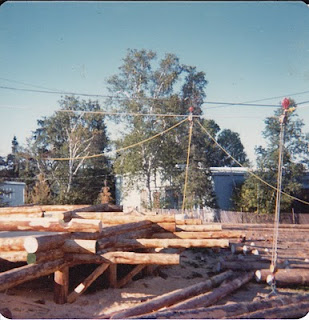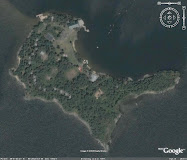This will eventually be a post about the building of Lount Lodge.
Over the coming weeks and months I'll add the bits and pieces I have, and what I remember, to put down in one place how a bunch of us built Lount Lodge.
Suggestions are welcome. Here's a bunch of paperwork to start things off, including The Rules. ~Bruce
Suggestions are welcome. Here's a bunch of paperwork to start things off, including The Rules. ~Bruce
We cut down 230 trees, all Red Pine, on McPhearson Island, which is about 90 minutes by boat south of camp near the U.S. border.
Bob Backhouse drove the skidder, used to haul or drag the trees we cut down, to a ramp we built on the shore of the lake. Where the tree was cut down, we "limbed" it; cut off as many branches as possible. At the ramp, a short distance away from the cutting area, we had an electric generator for a big drill.
Once Bob had dropped off a tree, sometimes more than one with the skidder, we manhandled them into place to drill holes at either end to allow steel cables to be threaded through to make the boom. Once the holes were drilled, we rolled the logs down the ramp into the lake. As more logs were rolled in the water, we got in boots and all and made the boom.
We lived on-site for about three weeks, camping on a small island a short distance away. We lived on mostly on trail food.
We named the island Ralph Island after Bob and I (left alone to fend for ourselves; big mistake) cooked up some mac and cheese and added bacon that was well past its prime. We figured if we cooked it long enough we'd be safe. We were wrong. By dawn we, in unison, were drowning out the sound of the birds.
Bringing the boom to camp was a hoot, but it was also a challenge none of us could have even imagined. What could go wrong did. Almost.
We were delayed in bringing the boom to camp because a severe storm that lasted a couple of days. On the day before we arranged to tow the boom to camp, towed by a tug (a picture of it at dock in Kenora is at the right) we left camp by boat at about 5 a.m. to check on any damage the waves caused to the boom.
When he got to McPhearson we discovered many of the cables had broke, and we had to rebuild the boom and fetch wayward logs. About 16 hours later, working in cold, fishfly invested water, we finished. But we were still far from home.
When he got to McPhearson we discovered many of the cables had broke, and we had to rebuild the boom and fetch wayward logs. About 16 hours later, working in cold, fishfly invested water, we finished. But we were still far from home.
I have a letter I wrote home about what happened next, and will post some of the contents of it when I get the chance. Reading the letter, written in early July 1980, it's clear I have forgotten a lot.
Suffice it to say, cutting down the logs and getting them to camp was gruelling work, all of it. But it was nothing to what was ahead. None of us had done this type of work before. Except for Burton, we were all university students without a clue.
Burton had learned to build with logs at the B. Allan Mackie School of Logbuilding in Prince George, B.C. Slowly, in my case really slowly, he taught us the craft of building with logs from ground up. When the building was finished Mackie published a story about the lodge in his Log House magazine. We were all quite proud. We were hoping to get the cover, but didn't. When you see what shot did make the cover of Log House #8, Mackie made the correct editorial decision.
There's a photo in the magazine of Dave Wright, Bob Picken and myself with the first log put on the building. I'm in the back picking my teeth with a peavy, a crude but functional tool used to roll and position logs. I figured by then I was tough enough to forgo a toothpick.
The lumber used for the joints was rough (not planed or sanded, but full of slivers) 2" by 12" lumber which were notched or "stepped" into the first layer of logs.
Air nail guns weren't invented yet so we used big-assed Estwing framing hammers and long ardox or spiral nails to nail the joists and cross supports together. The joists were spaced one-foot apart, which makes the floor in the lodge solid enough to land the space shuttle. It was built as solid as it is because over the next year we would use the floor as a heavy-duty work space. On top of the joists we nailed one-by-six shiplap at a 45 degree angle, again to provide additional support.
Over the next few months, while moving logs into position for successive rounds (layers), the occasional log crashed through the shiplap, but never through a joist.
All the lumber, and nails by the box, had to be barged (on the same barge pictured above) out to the island from a local mill. I don't remember much about this, probably because it sucked so much, but we were the people who loaded by hand the barge at the mill and then unloaded it at camp.
What I do know is that the tools Burton ordered us to buy were the best money could buy, designed to last forever. I still have mine. Despite Mike Holmes and his crew always using air nailers, I'll stick to my Estwing. Nothing beats pounding nails. I still have a few nails, too.
Burton also ordered us to wear hard hats on the job site, but that didn't last long. We figured should a log hit one of us a hard hat would offer little protection other than being a brain bucket.
But before we could move logs around we had to finish peeling them, which was mind-numbing work. Yup, I was good at it.
We also had to build a way to move the logs. That involved the building of a skyline powered by a winch strong enough to pull the logs out of the lake, and position them on the building.
I've added a couple of old photos showing the building's progress over a couple of months in the summer of 1980. By late summer the floor was in. If you look closely you can see the shiplap on a 45-degree angle. In the photo of the left we're now on the third round.
In the next photo, taken in October of 1980, we'd come along way. (Click on them to enlarge).
In both shots you can make out the skyline, the rope/pulley/winch system we used to move the logs around the construction site. The pictures were taken from the roof of the old rec hall.
In the first photo on the page, the plaque, I'm guiding the people on the winch when to give tension and not. When the walls started getting higher, the people on the winch couldn't see anything, so we needed a system of hand gestures from people at different spots to communicate.
 The winch was powered by a gasoline engine, and when it was fired up, you couldn't hear a thing, so hand gestures were our only option. You can see the winch in the first large photo above on the left, the greenish-looking thing at the back of the building where the fireplace is now.
The winch was powered by a gasoline engine, and when it was fired up, you couldn't hear a thing, so hand gestures were our only option. You can see the winch in the first large photo above on the left, the greenish-looking thing at the back of the building where the fireplace is now.Sitting at the back are Bob Backouse in the green T-shirt, Pam MacLean in the middle and Dave Wright.
Through a series of rope and pullies, the winch/skyline was connected to four log posts we had erected. You can see one in the back right corner of the building near the white building, the then hospital. The block-and-tackle skyline can be seen in the smaller photo on the right. You can also see the "tongs" we used to hook and grab onto the logs when we moved them around.
These post-end were dug into the ground and anchored by a concrete base and guy-wire cables, so when we lifted a big log, they didn't snap under the strain. One of the four posts at the front had its guy-wires anchored into the bed rock where kids catch crayfish now. We had to drill into the bedrock and pound in steel pegs called "thunderbolts" to attach the guy-wires, the other end attached to the very top of the post. We cut off the thunderbolts when the building was finished, but the holes are still there.
The winch Burton built, through trial and error, soon became a miracle of design and engineering. A perfect combination of form and function. It was beautiful. Some days when we lifted heavy logs, the winch drum and rope burned.
| Graham Lount - Lount Lodge rededication Aug. 24, 2012 |






















Never mind all of the logs cut the winter before which, due to an error in location, had to be confiscated.
ReplyDeleteLooking forward to reading your entries. I got to work on the project much later (winter 1982) when the finishing touches were put on.
Don, that escapade delayed the project by a few months if not longer.
ReplyDeleteIf I remember, the logs were cut down in winter on Crown land without the proper permits. Camp had hired a local contractor to do this, someone we thought that could be trusted, but that wasn't the case.
The logs were later auctioned off, I believe, to a local First Nations community.